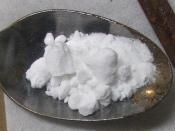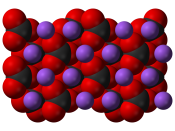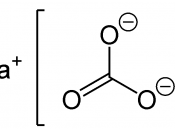2
TITRATION
Aim:
To determine the volume of dilute hydrochloric acid of concentration 0.36 mol/dm3 used to neutralize 25cm3 solutions of sodium carbonate with concentrations 0.5 mol/dm3 and 0.125 mol/dm3, keeping the concentration of dilute hydrochloric acid constant and the volume of sodium carbonate constant, with the help of an indicator.
Chemical Required:
Sodium Carbonate (13.25g, 53.0g)
Hydrochloric Acid (0.36 mol/dm3, 500cm3 per trial)
Apparatus:
Apparatus | Quantity | Uncertainty |
Digital Balance | 1 | 0.001g |
Petri dish | 1 | - |
Spatula | 1 | - |
Conical Flask | 1000ml | 0.5ml |
Beaker | 50ml | - |
Wash bottle | 1 | - |
Dropper | 1 | - |
Burette | 50ml | 0.05ml |
White tile | 1 | - |
Filter Funnel | 1 | - |
Pipette | 25ml | - |
Labels | 10 | - |
Pen | 1 | - |
Variables:
Independent Variable: Volume of hydrochloric acid
Dependent Variable: Point of neutralization with the help of indicators
Perform all repetitions in the same room, within half an hour of the first trial
Controlled Variables:
The temperature and pressure of the surroundings (RTP)
Volume of sodium carbonate solution - 25cm3
Volume of water in sodium carbonate solution - 1000ml
Purity of water (pH) in sodium carbonate solution
Concentration of dilute hydrochloric acid - 0.36
mol/dm3
Amount of phenolphthalein - 2 drops
Apparatus
Methods of Controlling Variables:
Perform all repetitions in the same room, within half an hour of the first trial
Use the same pipette for measuring the volume of Na2Co3 solution
Use the same conical flask to measure the volume of water
Use distilled water, distilled in the same batch
Use the same dilute hydrochloric acid for each trial
Use the same dropper for adding phenolphthalein for each trial
Use the same apparatus for each trial
Procedure:
Prepare a 0.5 mol/dm3 solution of sodium carbonate.
Place an empty petri dish on the digital balance.
Make sure that the balance reading is now at 0.0g.
Using a spatula, add Na2Co3 on the petri dish until the reading shows 53.0g.
Add the sodium carbonate in a conical flask of capacity 1l, using a funnel.
Pour distilled water in a wash bottle, distilled in the same batch.
Pour the water, in the conical flask, to dissolve the sodium carbonate until the 1000ml mark.
Similarly, prepare a 0.125 mol/dm3 solution of sodium carbonate by weighing 13.25g of sodium carbonate and dissolving it in 1l of distilled water, distilled in the same batch the water used in the preparation of 0.5 mol/dm3.
Divide the prepared solutions of sodium carbonate
Using a pipette of capacity 25cm3, pour the 0.125-mol/dm3 solution of sodium carbonate in 5 different conical flasks.
Use a conical flask with minimum capacity of 50ml.
Use the same pipette to measure each volume of the solution.
Repeat the same with the 0.5 mol/dm3 solution of sodium carbonate.
Label each flask with the concentration and a number e.g. 0.5 - 1
Add 2 drops of phenolphthalein in each flask using the same dropper.
The 0.36-mol/dm3 solution of dilute hydrochloric acid is poured in the burette.
Clamp a 50ml burette onto the stand.
Place a filter funnel on the top of the burette.
Pour the dilute hydrochloric acid of concentration 0.36-mol/dm3 in a beaker.
Fill up the burette with dilute HCl from the beaker, up to the zero mark using the funnel.
Remove the filter funnel.
Place the conical flask "0.5 - 1" containing the 25cm3 of Na2Co3 solution of concentration 0.125 mol/dm3 under the burette on a white tile.
Dilute hydrochloric acid is added to the flask in small quantities.
Pour no more than 0.5cm3 of acid at a time.
Keep swirling the contents of the flask after each addition of acid so that the colour change is distinctive.
The acid is added until the pink colour of the indicator just disappears. This is called the end-point.
Record the final reading on the burette at end-point in to a notepad.
Repeat from step-6 onwards with baker no's 2, 3, 4, 5 for concentration 0.5 mol/dm3; and then for 0.125 mol/dm3 of sodium carbonate.
Perform all repetition on the same day, within half an hour of starting the experiment.
These repetitions should take place in the same room and spot.
[1: ]
Raw Data Table:
Volume of dilute hydrochloric acid needed to neutralize sodium carbonate
Concentration of sodium carbonate (mol/dm3) | Volume of hydrochloric acid (cm3) | |||||
Trial 1 | Trial 2 | Trial 3 | Trial 4 | Trial 5 | Average | |
0.125 | 8.5 | 7.1 | 8.7 | 7.4 | 8.6 | 8.06 |
0.5 | 33.8 | 35 | 32.6 | 36.1 | 32.8 | 34.06 |
Sample Calculation:
Standard Solution of sodium carbonate (0.125 mol/dm3):
1 mole is 106g, so 0.125 is 106 * 0.125 = 13.25g.
Theoretical end-point: (0.125*25)/0.36 = 8.7 cm3
(8.5+7.1+8.7+7.4+8.6) / 5 = 8.06
The accepted value has been taken from my hypothesis (Theoretical end point)
[(8.7-8.06)/8.7]*100 = 7.356%
Percentage Uncertainty = Uncertainty/Measured x 100
0.5/8.06*100= 6.203%
All calculations to find the mean and standard deviation have been done using Microsoft Excel by using the AVERAGE and STDEV functions.
Qualitative Analysis:
The sodium carbonate was white and powdery. When dissolved in water, a colourless and soapy solution was formed after constant stirring, as sodium carbonate took a while to dissolve. The sodium carbonate solution turned red litmus paper to blue.
The dilute hydrochloric acid was colourless, and when poured into the beaker, a strong scent with a bit along with white clouds was observed. It turned red litmus paper blue.
Phenolphthalein, turned pink when added to sodium carbonate solution
The pink solution then turns to lighter shades of pink to colourless after the addition of HCl.
Concentration of sodium carbonate (mol/dm3) | Volume of hydrochloric acid (cm3) | STDEV | Percentage Error % | Percentage Uncertainty % | |||||
Trial1 | Trial 2 | Trial 3 | Trial 4 | Trial 5 | Average | ||||
0.125 | 8.5 | 7.1 | 8.7 | 7.4 | 8.6 | 8.06 | 0.750 | 7.356 | 6.203 |
0.5 | 33.8 | 35 | 32.6 | 36.1 | 32.8 | 34.06 | 1.486 | 1.844 | 1.468 |
Processed Data Table:
1


